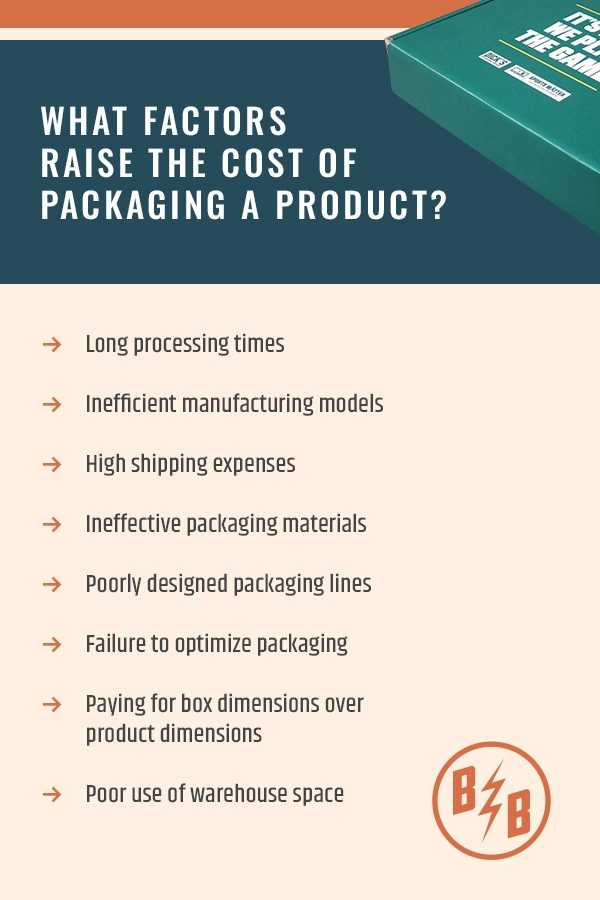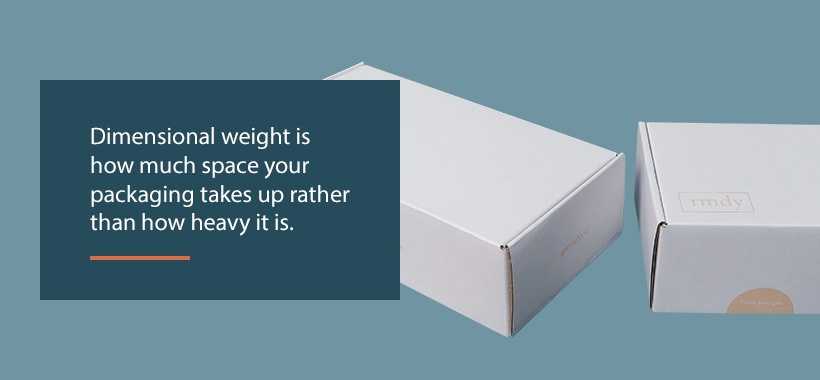
Every company that ships products to its customers knows the importance of high-quality packaging. Your packaging does more than just house goods — it also provides sales and marketing benefits, such as improving brand association, attracting consumer interest and increasing product value. With these characteristics in mind, it’s clear packaging plays a valuable role in the manufacturing industry.
Manufacturers spend over $150 billion on packaging annually, which is approximately 7-10 cents per dollar that goes into the product. Optimizing packaging costs helps your company ensure the highest packaging quality while keeping costs as low as possible. There are dozens of factors that contribute to high packaging costs beyond the price of materials. You can learn how to decrease shipping costs by recognizing these factors and resolving them using some of our low-cost packaging tips.

If your business has high packaging expenses but can’t identify the cause, there could be a number of elements bogging down your bills. Some of the contributors to rising costs include:
If you’re paying too much for your boxes, there are several packaging improvement ideas you can implement to minimize costs while maintaining brand and product integrity. With these low-cost packaging strategies, your business can remain competitive and achieve greater profitability.
Consider introducing the following tips in your facility to reduce the cost of product packaging:
As your business grows, your need for packaging materials will too. And with dozens of different packaging mediums — ranging from cardboard to plastic to paper to stuffing materials — it’s important you conserve, group and store them accordingly. The better your material storage strategy, the more money your company can save in the long run while boosting overall warehousing speed and efficiency.
It’s a good rule to categorize similar materials together to streamline order fulfillment and reduce administrative workloads. Try assessing your current product packaging inventory, group like items and sort infrequently used materials into one area. Also, avoid ordering packaging materials in bulk. Though bulk purchasing is generally a better deal, it often leads to higher storage costs, which may outweigh your initial cost savings.
Manual packaging tasks can take up hours of valuable company time. For example, the time an employee takes to construct corrugated cardboard, insert stuffing materials and tape boxes shut could easily be used elsewhere. That’s why it’s wise to cut down time spent packaging products by hand by introducing automation technologies into your warehouse.
Most manufacturing industries in the United States have begun using automated technologies like robots to aid everyday tasks. Automation is designed to boost productivity and packaging speed while eliminating manual work redundancies. Other benefits of packaging automation include:

Many companies don’t realize the impact that dimensional weight has on their shipping costs. Dimensional weight is how much space your packaging takes up rather than how heavy it is. That means a package’s dimensional pricing can boost a company’s shipping costs, even if products are relatively light and compact.
For example, if you’re shipping bags of cotton balls in large, wide boxes that take up too much space, the dimensional weight of the packaging will hike up your shipping costs despite the fact that the cotton balls weigh practically nothing.
If you spend too much on shipping due to box sizes, consider these low-cost packaging alternatives:
Though a damaged product here and there may not seem like a significant loss, product returns can cost businesses thousands of dollars a year. Why? Because when a customer returns a damaged product, the company loses more than just the money spent manufacturing the product itself. They also suffer expenses from packaging, shipping and returning the item. Not to mention, customers who receive damaged items from poor packaging may develop a negative perception of the company and urge other consumers against choosing its products.
The average package is dropped 17 times during transit. That’s why it’s vital your packaging is durable, resilient and able to protect your products during shipping. You can safeguard your goods from damage with rigid corrugated boxes or cushioned, waterproof jiffy bags. You can also implement effective stuffing materials for impact protection, such as:
Due to fast-growing technological advances, ordering availability and shipping proficiencies, more and more consumers expect to receive their purchases with minimal wait times. That’s why it’s essential to achieve fast packaging turnaround times. The faster you obtain your packaging solutions, the faster you can send out orders and put products into your customers’ hands. Quick turnaround also minimizes the labor and production costs associated with product packaging.
You can increase turnaround speeds by investing in custom packaging from a company that produces its products in-house. When manufacturers design, develop, print and deliver packaging products in their own facilities without relying on outside organizations, they can send out packages faster. That means you’ll receive your packaging materials without the wait.
The more low-cost packaging you implement in your establishment, the more money you can save for your company. What many organizations don’t realize is that you don’t have to commit to just one type of product packaging — every packaging model has individualized benefits, so why commit to just one?
When you diversify your packaging with a mix of different methods and materials, you can achieve more desirable outcomes for your business. For example, durable corrugated boxes prevent transit damage, while compact, lightweight packaging reduces dimensional pricing expenses. When you invest in both of these packages, you can determine when to use each based on which would yield the bigger benefit in the circumstances.
For instance, you might use an impact-resistant cardboard box to package fragile items and lightweight packaging for smaller products with a lower risk of breakage. This way, you get the best of both methods.

You can also minimize the cost of packaging by improving your packaging design. If your packaging has a comprehensive color palette, you’re likely spending more than necessary on your design. You can minimize these costs by limiting yourself to one or two packaging colors. You can even implement more colors without significantly increasing costs by adding gradients or gray shading.
You should also keep colors in mind by using them to cater to the consumer. For example, studies show that customers perceived packaging with high-arousal colors like reds and yellows more positively than those with low-arousal colors like greens and blues. Being strategic in your product packaging can improve customer attraction and brand perception for your business.
It’s important to consider your packaging materials and how they affect the environment. When you prioritize sustainability by using recyclable materials in your packaging, you can minimize waste and reduce costs for your company.
Converting to greener packaging tactics can also create a more favorable reputation for your brand. Many customers value companies that prioritize sustainability and choose to support sustainable products. That means implementing environmentally conscious packaging methods can attract more customers to your company and boost revenue.
You can achieve more eco-friendly packaging by incorporating recyclable materials into your boxes, stuffing materials and ink. For example, you can use biodegradable material alternatives like mushroom packaging to eliminate waste or invest in recycled products made of cardboard or paper.
You can also go the extra mile in product sustainability by incorporating collapsible materials into your boxes. These structures make it easier for consumers to tear down and recycle your packaging after unboxing their items.
Your packaging line should feature cutting-edge machinery designed to produce high-quality products with optimal speed and precision. When your equipment improves your production line, it reduces staffing errors, increases efficiency and raises revenue.
If you don’t have the necessary machinery in your facility to produce the best packaging outcomes, you can partner with a company that does. Sometimes, it’s more cost-effective to outsource your packaging manufacturing to an experienced business that has the advanced tools, knowledge and resources needed to deliver the best results. This way, you won’t have to invest in expensive machinery yourself and spend time learning how to use it and training employees.
Product packaging comprises many parts and components, but not all of it adds value to the item. Many companies spend more on their packaging than what’s truly necessary. To ensure you’re not paying for more than what’s needed for your packaging solutions, try asking yourself the following questions:
Sourcing products from multiple suppliers can be expensive, raising delivery costs and complicating processes. For instance, if you decide to make changes to your packaging, you’ll have to contact all involved parties, make them aware of the changes and adjust all your orders, which can cost your company time.
When you commit to a single supplier for all your packaging materials, you can achieve lower prices per unit without having to negotiate costs across manufacturers. You can also obtain lower prices when ordering products in large quantities.
At Bolt Boxes, we set ourselves apart from other manufacturers with unbeatable lead times, top-of-the-line printing capabilities and next-level design expertise. We also emphasize the importance of sustainability, producing 100% recyclable packaging comprising 60%-95% post-consumer waste.
With over 60 years manufacturing high-quality packaging for our customers and an on-time percentage rate of 99%, we’re the company you can rely on. Get started with your low-cost packaging by navigating five simple steps on our website, and we’ll provide an immediate quote!